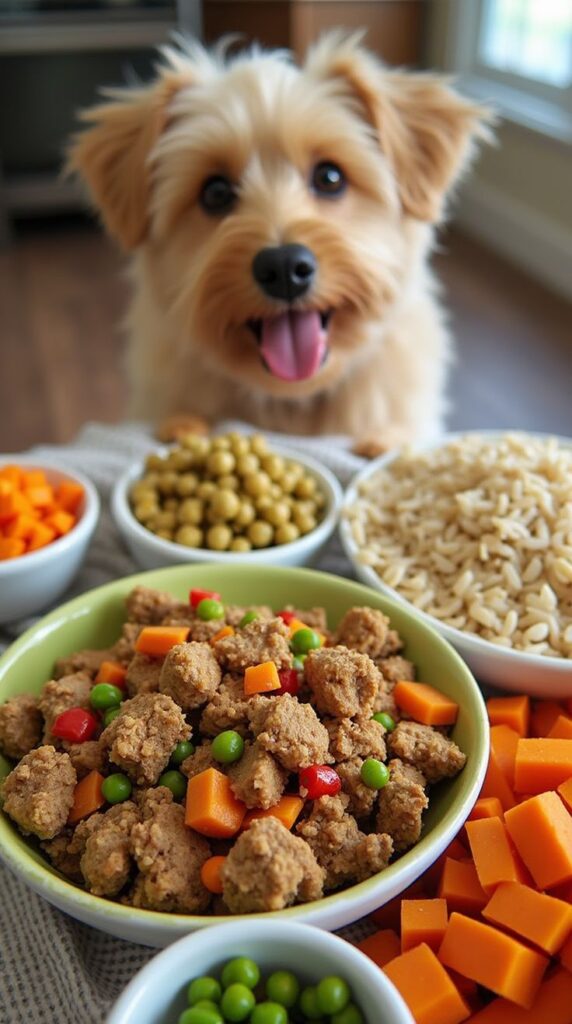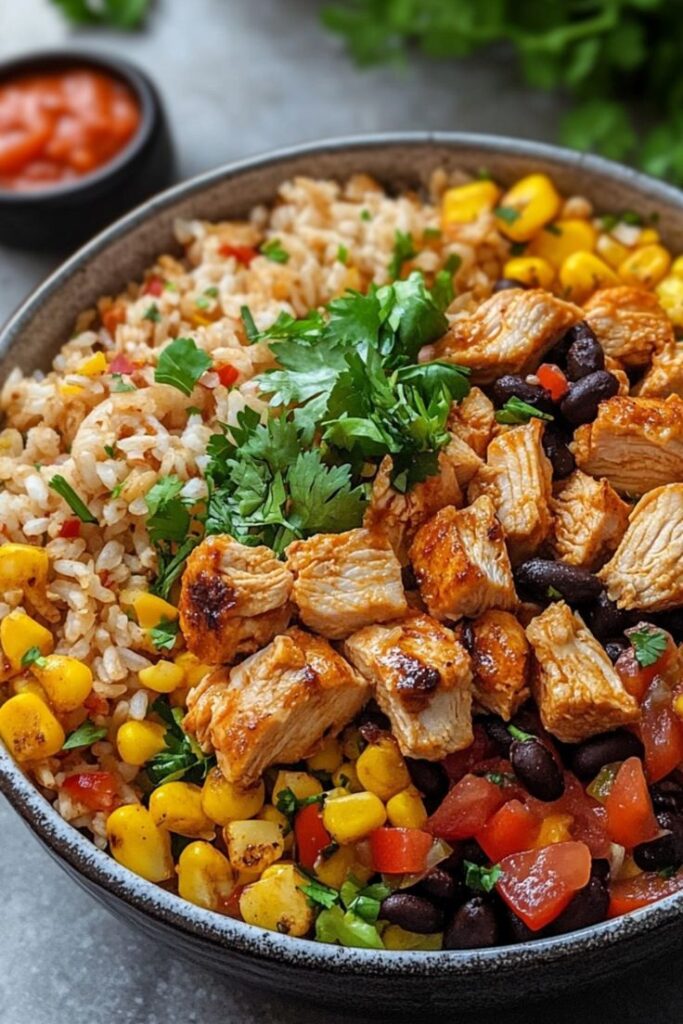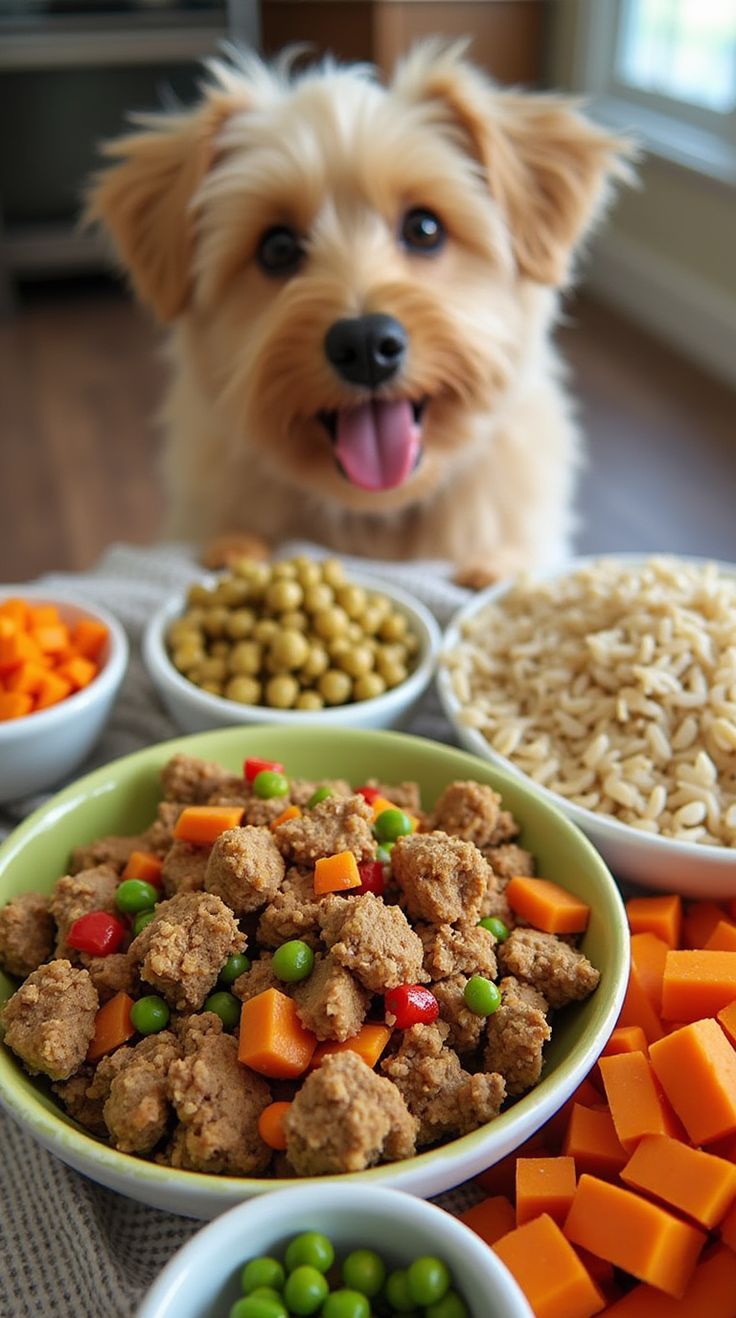5 Healthy Homemade Dog Food Recipes :Are you tired of reading confusing ingredient labels on commercial dog food bags? Want to provide your furry friend with fresh, nutritious, and safe meals? You’re not alone. Many dog owners are turning to homemade dog food recipes—not only to avoid fillers and artificial additives but also to ensure optimal health for their pets. In this comprehensive, vet-approved guide, we’ll dive deep into the best homemade dog food recipes, essential nutrients, safety tips, and feeding guidelines.
Let’s create delicious, healthy meals that your dog will love and your vet will approve!

Why Choose Homemade Dog Food?
Homemade meals give dog owners full control over what goes into their pet’s bowl. Here are a few compelling reasons to switch:
- Tailored nutrition based on your dog’s breed, age, and activity level.
- Avoid harmful ingredients like by-products, preservatives, and artificial flavors.
- Reduce risk of food allergies or sensitivities.
- Improve digestion, energy, coat condition, and overall wellness.
However, it’s crucial to ensure your homemade recipes are balanced and vet-approved. Dogs have specific nutritional needs—missing any key nutrient can lead to deficiencies or health issues.
Essential Nutrients in Homemade Dog Food
Before diving into recipes, understand the key nutrients your dog needs daily:
| Nutrient | Function | Best Sources |
|---|---|---|
| Protein | Builds muscles, supports immune system | Chicken, turkey, beef, fish, eggs |
| Carbohydrates | Provides energy | Rice, oats, sweet potatoes, peas |
| Healthy Fats | Supports skin, coat, brain, and heart | Fish oil, chicken fat, flaxseed oil |
| Fiber | Aids digestion | Carrots, pumpkin, green beans |
| Calcium & Phosphorus | Bone growth and maintenance | Eggshell powder, bone meal, dairy |
| Vitamins & Minerals | Overall health, organ function | Vegetables, organ meats, supplements |
Note: Always talk to your vet before changing your dog’s diet or adding supplements.
Vet-Approved Homemade Dog Food Recipes
Let’s explore 5 vet-approved recipes for homemade dog food. These recipes are safe, balanced, and designed for average adult dogs. You can tweak portions based on your dog’s size and needs.
1. Chicken & Veggie Rice Bowl

Best for: Dogs with sensitive stomachs
Ingredients:
- 2 lbs boneless skinless chicken thighs
- 1 cup brown rice
- 1 cup chopped carrots
- 1 cup green peas
- 1 tbsp olive oil
Instructions:
- Boil chicken until cooked. Shred it into small pieces.
- Cook brown rice as per instructions.
- Steam or boil carrots and peas.
- Mix all ingredients together. Add olive oil.
- Let it cool before serving.
Feeding Tip: 1 cup per 20 lbs of body weight, twice a day.
2. Fish & Sweet Potato Delight

Best for: Dogs with poultry allergies
Ingredients:
- 2 fillets of white fish (cod, haddock)
- 1 sweet potato, diced
- ½ cup chopped spinach
- 1 tsp flaxseed oil
Instructions:
- Bake or steam fish until cooked thoroughly.
- Boil sweet potato until soft.
- Lightly sauté spinach (no seasoning).
- Mix all, drizzle flaxseed oil on top.
Bonus: Omega-3s from fish support skin and coat health.
3. Beef & Pumpkin Stew
Best for: Active dogs needing high protein
Ingredients:
- 1 lb ground beef (lean)
- 1 cup canned pumpkin (plain)
- ½ cup green beans
- ½ cup oats
Instructions:
- Brown the beef in a non-stick pan (no oil or salt).
- Cook oats with water.
- Mix beef, oats, pumpkin, and green beans.
Storage Tip: Store in an airtight container in the fridge for up to 3 days.
4. Turkey & Quinoa Energy Meal
Best for: Medium to large breeds
Ingredients:
- 2 lbs ground turkey
- 1 cup cooked quinoa
- 1 cup shredded zucchini
- 1 egg (optional)
Instructions:
- Cook ground turkey thoroughly.
- Boil or steam zucchini.
- Mix turkey, quinoa, zucchini, and a scrambled or boiled egg.
Benefits: Great source of lean protein and essential amino acids.
5. Vegetarian Power Mix (Occasional Use)
Best for: Occasional meat-free days
Ingredients:
- 1 cup cooked lentils
- 1 cup brown rice
- 1 cup chopped carrots
- 1 banana (mashed)
- 1 tbsp coconut oil
Instructions:
- Cook lentils and rice separately.
- Steam carrots.
- Mix everything together, including banana and coconut oil.
Note: Dogs are omnivores but still need meat. This is not a permanent meat replacement.
Ingredients to Avoid in Homemade Dog Food
Certain foods are toxic to dogs. Never include the following in your homemade meals:
- Onions & garlic
- Grapes & raisins
- Chocolate & caffeine
- Avocado
- Nuts (especially macadamia)
- Raw yeast dough
- Artificial sweeteners (like xylitol)
Always research before adding something new or better—consult your vet.
Portion Size & Feeding Chart
Every dog is different, and meal portions depend on weight, age, activity level, and health conditions.
Sample Feeding Chart:
| Dog Weight | Daily Food Amount | Meals per Day |
|---|---|---|
| 10–20 lbs | 1 to 1.5 cups | 2 |
| 21–40 lbs | 2 to 2.5 cups | 2 |
| 41–60 lbs | 2.5 to 3.5 cups | 2 |
| 61–80 lbs | 3.5 to 4.5 cups | 2 |
| 81+ lbs | 4.5+ cups | 2 |
Tip: Split meals into morning and evening to prevent bloating and overfeeding.
Should You Add Supplements?
Even with the best homemade dog food recipes, your dog might lack some essential nutrients—especially calcium, vitamin D, E, and omega-3s. Many vets recommend:
- Fish oil or salmon oil – for skin, joints, heart
- Multivitamin powder – covers basic nutritional gaps
- Eggshell calcium – homemade or powdered form
- Probiotics – improves gut health
Always consult your vet before introducing any supplements.
Storage & Meal Prep Tips
- Store cooked meals in airtight containers (lasts 3–4 days in the fridge).
- Freeze extra portions in labeled bags for up to 2 months.
- Thaw frozen food in the refrigerator overnight—not at room temperature.
Batch cooking once or twice a week can save time and ensure your dog never misses a healthy meal!
Frequently Asked Questions (FAQs)
1. Can I feed homemade dog food every day?
Yes, if the recipe is balanced and approved by your vet. Avoid feeding the same meal daily—rotate recipes for variety.
2. Is raw food better than cooked?
Raw food diets (BARF) are controversial. Many vets prefer lightly cooked meals for safety against bacteria and parasites.
3. How do I transition my dog from kibble to homemade food?
Start by mixing 25% homemade food with 75% kibble. Gradually increase homemade food over 7–10 days.
4. Do I need to add salt?
No! Dogs get enough sodium from natural ingredients. Extra salt can cause kidney strain.
Final Thoughts
Making homemade dog food isn’t just about feeding—it’s an act of love. It’s a commitment to your dog’s health, happiness, and longevity. By following vet-approved recipes, using fresh ingredients, and ensuring balanced nutrition, you’re setting your dog up for a vibrant life.
Take time to understand your dog’s needs, experiment with different ingredients, and consult your vet regularly. Remember: A healthy dog starts with a healthy bowl.
Ready to Cook for Your Dog?
If you found this guide helpful, don’t forget to bookmark it, share it with fellow dog parents, and check out our other expert blogs on BarkMeowHub.com!
